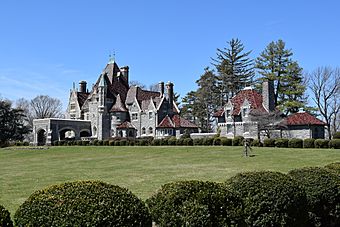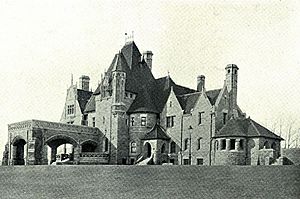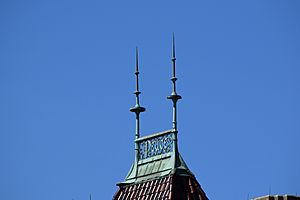Woodmont (Gladwyne, Pennsylvania) facts for kids
|
Woodmont
|
|

Woodmont in 2017
|
|
| Location | 1622 Spring Mill Rd., Gladwyne, Pennsylvania |
|---|---|
| Area | 72 acres (290,000 m2) |
| Built | 1891-94 |
| Architect | William Lightfoot Price |
| Architectural style | Châteauesque |
| NRHP reference No. | 98001192 |
Quick facts for kids Significant dates |
|
| Added to NRHP | August 5, 1998 |
| Designated NHL | August 6, 1998 |
Woodmont is a huge mansion and estate covering 72 acres in Gladwyne, Pennsylvania. It's a special place because it was named a National Historic Landmark in 1998. This means it's a very important historical site, especially for its beautiful French-style architecture.
Contents
Building Woodmont: A French Castle in Pennsylvania
Woodmont was designed in 1891 by an architect named William Lightfoot Price. He built it for Alan Wood, Jr., who was a very successful businessman in the steel industry and a former U.S. Congressman. The mansion looks like a French castle and was finished in 1894. It cost a lot of money to build, about one million dollars back then!
Amazing Views and Inspiration
The mansion sits high up, offering amazing views for 15 to 20 miles around. You can see the Schuylkill River and the town of Conshohocken, Pennsylvania from there. The Schuylkill Expressway even passes hundreds of feet below the estate.
The design for Woodmont was inspired by another famous mansion called Biltmore Estate, located in Asheville, North Carolina. The architect, William Lightfoot Price, knew the Biltmore Estate well because he had designed a hotel nearby.
What Was on the Estate?
Woodmont had many cool features. It included tennis courts, a swimming pool, and stables for horses. There were also several smaller buildings, greenhouses, a stream, and walking paths. The original property was much larger, over 400 acres! It even had a working farm with two dairy barns, and one of them is still there today.
Who Lived at Woodmont?
Alan Wood, Jr. lived at Woodmont for less than ten years. A year before he passed away in 1902, he sold the estate to his nephew, Richard G. Wood. Richard lived there for 28 years. In 1929, Richard started selling off parts of the land. He sold 200 acres to the Philadelphia Country Club.
Woodmont and the Peace Mission Movement
Today, Woodmont is the main center for the International Peace Mission movement. A leader of this movement, Father Divine, was given the estate by one of his followers, John Devoute, in 1953.
Renovations and Patriotism
Father Divine's followers worked hard to fix up the mansion. They put a large American flag out front to show Father Divine's patriotism. They also added a garden, similar to gardens at other Peace Mission properties. They held an open house for everyone to see the renovated mansion from September 10 to 12, 1953.
A Special Place Today
Followers visited Father Divine at Woodmont until he passed away in 1965. Everything in his rooms, even an old television set, has been kept exactly as it was when he passed. The estate is now a special place that honors his life. It also serves as a meeting spot for the few followers who remain today.
Visiting Woodmont
You can visit Woodmont on Sunday afternoons. It is open from April to October. The guided tours are free, so it's a great chance to see this historic mansion!
See also





